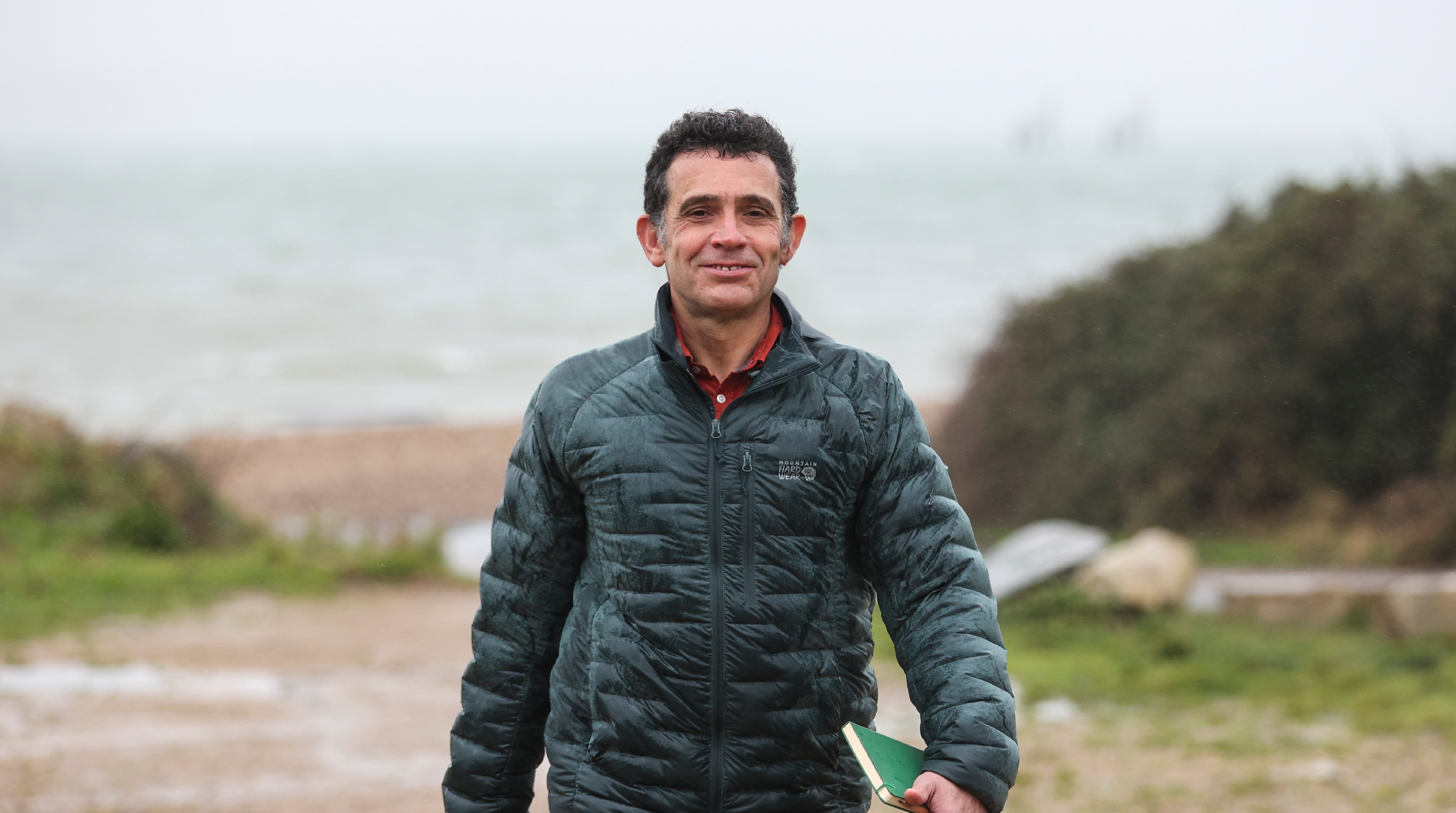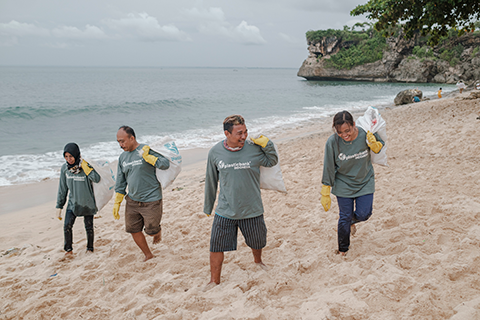Paul Riggs: Advancing CooperVision’s Sustainability Journey

When Paul Riggs’s daughter announced that she was studying biology at university, he was both proud and surprised, as he had never expected her to follow a career path so similar to his own.
Paul, whose educational journey and three-decade career have been steeped in the sciences, brings a wealth of knowledge and dedication to his current role at CooperVision as our Director of Science and Sustainability. He guides his teams with a distinctive collaborative energy, which ensures everyone understands the potentially profound impact of their work. While his forward- thinking approach aims to yield lasting benefits for People + Planet, our initiative that aims to conserve natural resources, reduce greenhouse gas emissions from plastic production, and empower people to make environmentally conscious choices, he is already seeing how sustainability changes are impacting future generations.
Advancing Sustainable Practices at CooperVision
Paul plays a crucial role in progressing our sustainability efforts across CooperVision and around the world, as he strives to find areas in which to minimize our possible environmental impact and support People + Planet. His objective is to act as a catalyst for progress, even if the individual steps are small, by harnessing the energy of his teams. He brings together diverse teams of innovators and challenges them to find ways to source, design, and recover to reduce our carbon footprint.*†‡1,2
“In my view, the medical device industry has often been historically complacent when it comes to sustainability efforts because the very nature of what they produce has such a positive impact on the end user,” he explains. “But this is no longer an excuse. Our products should help to improve the well-being of both people and planet. This is why it’s important to assemble a capable team—to harness their collective strengths. With everyone aligned to a common objective at CooperVision, collaboration becomes the cornerstone of achieving our goals.”
This means Paul engages with individuals involved in all parts of the contact lens production cycle process. Some days, you’ll find him collaborating with the Global Sourcing Team, analyzing materials procurement, manufacturing processes, and supply chains. Other days he will be engaged with suppliers to enhance the potential sustainability of our products and packaging, with a specific focus on minimizing our carbon impact and efficiently using resources.

At CooperVision, we’re offsetting waste from our products and packaging that cannot yet be reclaimed and making a measurable difference through net plastic neutrality.§1 Paul partnered with Carol Herring, CooperVision’s Global Packaging Material and Technology Manager, and her team to carefully calculate plastic usage throughout our product range. This project has since transformed into our net plastic neutrality initiative with Plastic Bank, which funds the collection and recycling of ocean-bound plastic equivalent to the weight of plastic used across a selected range of our products.|3 Plastic Bank collects, weighs, sorts, chips, and melts the gathered plastic waste into pellets, which are then sold as “raw material feedstock” to be repurposed into everything from bottles for cleaning products to clothing.4 To date, the effort has prevented the equivalent of more than 305 million plastic bottles from entering the oceans.¶5
Paul’s team has worked closely with Environmental, Health, and Safety with the aim of increasing the sustainability footprint of our operating and manufacturing sites. Seven of our manufacturing facilities have been recognized LEED® certifications or BREEAM® ratings.**6 The LEED® (Leadership in Energy and Environmental Design) rating system is a globally recognized symbol of excellence in green building7 and has been awarded to our contact lens manufacturing facilities in Juana Díaz, Puerto Rico, Alajuela, Costa Rica, and Scottsville, N.Y., as well as our distribution centers in West Henrietta, N.Y., and Spain. A secondary packaging and distribution facility in the U.K also holds a BREEAM® “Excellent” rating. BREEAM® (Building Research Establishment Environmental Assessment Method) is a voluntary system that assesses a building’s performance on environmental issues.8
Shifting Mindsets for Meaningful Change
Paul’s diverse responsibilities converge to help propel CooperVision’s sustainability journey forward, beginning with actively challenging mindsets to recognize that prioritizing sustainability is not merely a choice but a fundamental responsibility.

Paul emphasizes the importance of being mindful of decisions that will have an environmental impact. “Initiating sustainable behavior starts with shifting mindsets,” remarks Paul. “For example, when the U.K. government required certain retailers to start charging consumers a 5- pence charge for plastic shopping bags, it was initially seen as a measure to reduce plastic waste. However, over time, people internalized this concept, feeling a sense of guilt even considering paying the fee, despite its affordability. Altering people’s sustainability mindsets involves empowering them to recognize their capability to effect change for the greater health of the planet.”
His recognition of the importance of shifting mindsets for meaningful change is a key factor in his success in driving our sustainability goals forward. He knows that we may not have complete answers to all our sustainability challenges right now, but he believes that something needs to happen now, and we can’t wait for perfection – and there is always room for improvement and enhancement.
“Ultimately, it’s about making choices that benefit the future of our planet and the well-being of generations to come. I shared earlier that my daughter is pursuing biology. She represents the future, the next generation that we’re striving to protect,” says Paul. “She’s interested in biodiversity and ecology and how to engineer the world for the future. When I share with her some of the initiatives that are part of CooperVision’s sustainability journey, she thinks we are doing the right things, which makes me believe that while the path might be tough, challenging, and demanding, tackling these difficulties is essential. Positive change often comes from confronting and overcoming challenges.”
Explore more and see how we're taking steps towards a brighter tomorrow.
* Refers to continuous manufacturing improvement processes undertaken by CooperVision to reduce its Scope 1 and 2 carbon emissions.
† Carbon footprint is limited to Scope 1 and 2 emissions, defined as: Scope 1 emissions are direct emissions from owned or controlled sources. Scope 2 emissions are indirect emissions from the generation of purchased energy.
‡ CooperVision’s 2022 Environmental, Social, and Governance Reports.
§ Refers to CooperVision’s net plastic neutrality initiative with Plastic Bank.
│ Plastic used in participating CooperVision soft contact lens products is determined by the weight of plastic in the blister, the lens, and the secondary package, including laminates, adhesives, and auxiliary inputs (e.g., ink). The determination does not include plastic used during the manufacturing process for both these products and their packaging.
¶ CooperVision, through its collaboration with Plastic Bank, to have collected and converted approximately 6.1 million kg of plastic destined for waterways as of 01/2024. Using Plastic Bank’s metric of 1 kg of plastic equaling 50 standard 202mm bottles, that will be the equivalent of approximately 305 million plastic bottles not reaching our oceans.
** LEED: Leadership in Energy and Environmental Design. BREAM: Building Research Establishment Environmental Assessment Methodology.
References:
1. CVI data on file, 2023.
2. CVI data on file, 2020-2023, including Zero Waste to Landfill Report by Manufacturing Site indicating reclamation efforts by waste stream (2022).
3. CVI data on file, 2024.
4. Plastic Bank. "About Plastic Bank -- Committed to Sustainability Goals." Accessed March 19, 2024. http://plasticbank.com/about
5. CVI data on file as of 01/2024.
6. CVI data on file, 2023. US Green Building Council.
7. U.S. Green Building Council. "LEED -certified green buildings are better buildings." Accessed March 19, 2024. https://www.usgbc.org/leed
8. The BRE Group. "How BREEAM works." Accessed March 19, 2024. https://bregroup.com/products/breeam/how-breeam-works/#:~:text=The%20BREEAM%20ratings%20range%20from,stars%20on%20the%20BREEAM%20certificate
SA11448/APP124972





